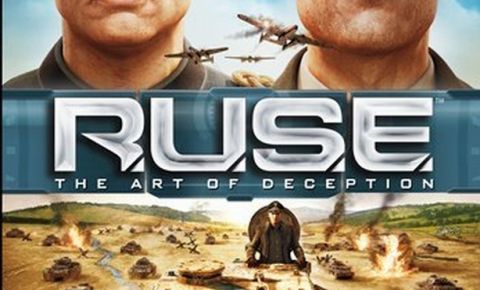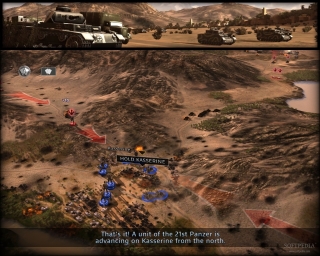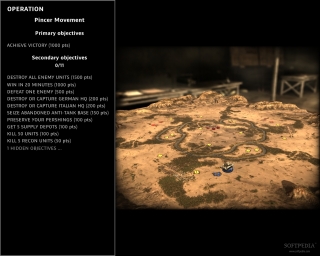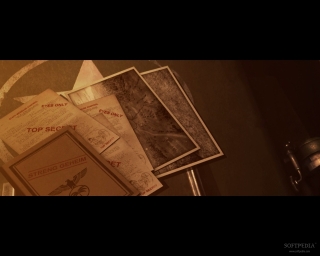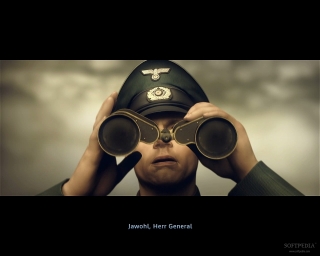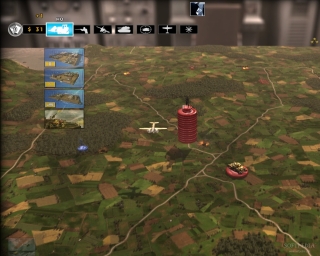It's hard to go back to World War II. I lost count of the number of times I stormed the beaches of Normandy, both as a lowly grunt in one of the landing ships, swimming to shore and assaulting pillboxes, and as a high level commander, preparing the orders for my men and hoping that the Germans are not too well prepared for the invasion.
Whenever a new World War II game pops up I think about what gameplay innovation it must introduce in order to make the tired old setting fresh again.
This feeling seems to have been present at Eugen Systems, the developers of R.U.S.E. and the people behind the two Act of War titles. Still the team decided to take on the challenge and go back to World War II while proving that solid and innovative mechanics can make any setting interesting again. But I am convinced that their gameplay innovation would have been better served by choosing another setting, possibly a more modern one.
The innovation comes from the titular ruses, tricks in the form of special powers that can are used to completely transform the way a World War II strategy game is played, bringing it closer to the realities of warfare and showing how lack of information or uncertainty about it can change decisions and create tension during a battle.
Story
The single player campaign in R.U.S.E. is pretty long, initially following a young general in the United States army as he fights his way from North Africa to Italy and France and then, finally, Germany, and then jumping into the well polished boots of a German general for more of the same (sadly, the innovation in terms of gameplay does not extend to the narrative).
The main problem with the single player is that there are lot of custscenes and interruptions and, unfortunately, most of them have no actual value at all, either from a storytelling or a stylistic standpoint. The dialog feels old and uninspired, the characters are pretty unlikeable, especially the American main hero who the player is supposed to relate to, and the game is a bit too eager to emphasize talking heads and intrigue over delivering information about the actual World War II battles the player is guided through.
The pacing is also off, with the initial missions seemingly taking ages while the player only has control over limited numbers of infantry and anti tank units. If all feels very boring for the first few hours but it then manages to offer some pretty interesting tactical challenges that can be solved in a few clever ways.
Gameplay
R.U.S.E. manages to be simple and complex at the same time, with mechanics that are simple to understand but pretty hard to master.
The game features infantry, recon units, tanks, tracked artillery, bombers and fighter, anti air guns, anti tank batteries and more units that are controlled as in any other strategy title, using the mouse to select them and set destinations. Each of the units is built using the looks and the characteristics of real world weapons from World War II.
Players get resources by truck from supply points that they built and create structures to get access to the different types of units. So far it's all so traditional. There's a rock, paper, scissors system where infantry get killed by tanks, with AT guns owning them but unable to engage infantry. Artillery and air power are more indirect in their effects and players can, depending on the faction they choose, have access to other toys to influence the balance on the battlefield.
But R.U.S.E. has another set of mechanics linked to abilities called ruses, which allow the player to alter the way his units behave or the way his enemy perceives the battlefield.
Blitz, maybe the most used ability in multiplayer, increases the speed of units. Radio Silence hides everyone in one sector of the map. Terror makes enemies flee faster. Fake Offensives, in the varieties, create assault units that can only be seen as decoys after they have been shot at least once. Camo Nets allows for structures to be hidden from view. Spies are used to show enemy units in some sections of the map.
All these ruses mean that controlling supply and creating well rounded forces is only one element of a successful strategy. The player also needs to control his intelligence, have a good view of the battlefield and do his best to misdirect and trick his opponent into an unfavorable position. It's like playing a normal strategy title while also engaging in a bit of chess.
It might not sound like much but it's a reinvention of the World War II strategy genre that equals that of Company of Heroes, although on another scale. It captures some of the chaotic nature of warfare and partly reflects the situation of high level generals during the World War, needing to act decisively without having all the data needed to make perfect decisions.
The great news is that R.U.S.E. does not rely on clicks per minute and no amount of speedy clicking will save a player from a stupid tactical decision. This is a title which values sneaky players and traps over frontal attacks and stupid heroism.
One word of advice: never underestimate the power of infantry. Some people tend to go only for tanks and planes and long range guns in the middle and late game but I've seen a lot of armor and heavy units get ambushed and annihilated by lowly infantry hiding out in town squares or in woods. Very careful recon work is needed before deploying any heavy and costly units in these kinds of areas.
Graphics and audio
R.U.S.E. looks very good and the developers at Eugen System manage to get a lot out of their game engine, which allows gamers to zoom out high enough to see the edges of the map and the actual war room where it is set while also offering the option to them to zoom in close enough to see individual tanks firing and infantry squads getting bombed to bits.
I mostly played the game zoomed out, with the units represented as poker chips and the powers that are in effect clearly visible on the map. The view makes it easier to direct attacks and prepare ruse deployment but my preference for it does not mean that the zoomed in view is not beautiful on its own.
The military hardware of the era is pretty well modeled and the effects looks pretty good, especially the explosions. But after a while it all gets a bit boring for the more strategy minded player and the need to see more of the battlefield wins out over the beauty of the terrain and models. The only times I now zoom in are when I staged a beautiful ambush and want to see the destructive effects of my artillery and infantry on enemy armored colums.
The IRISZOOM Engine is really powerful. I never noticed any clear slowdowns, whether I was zoomed out or in, with the only issues being linked to how quickly the terrain was textured when zooming in very, very quickly, going from the chip based view to ground level.
The music and voices are competent but do little to contribute to the atmosphere. The cutscenes are especially bad, with characters that lack any clear motivation and rather tenuous links to actual history. The messages the player receives during the single player campaign missions are no better.
The game does a neat little thing when it mixes the actual view of the battlefield with a short scene playing above, below or on the side, suggesting what will happen next and how to respond to it. I would have preferred to see more of this mash ups than the stilted cutscenes.
Multiplayer
R.U.S.E. is primarily a multiplayer experience and it's the kind of game that will welcome, with arms open, those who are tired of the huge numbers of units in Supreme Commander 2 or the speed and build order adherence required to succeed in Starcraft 2. The experience is much more focused and, at the same time, accomodating.
It helps that up to eight players can join in and that there are enough playable factions to keep engagements interesting over the long term.
It's also pretty easy to find opponents at the moment, with the only downside being that most of them seem to have at least some experience with the beta stage, meaning that some early games might be pretty brutal defeats.
The only problem is that the game can feel too slow at times, especially in the first few minutes of a battle, when all the player has to do is wait for the money to get some units up and running before taking the fight to the enemy.
I truly hope that the game does well and the developers at Eugen Systems are able to use their ruse and force system to create a more modern real time strategy experience with a stronger story.
The Good
The Bad
Conclusion
 14 DAY TRIAL //
14 DAY TRIAL // 